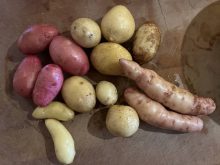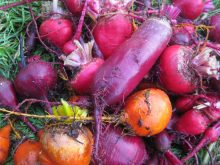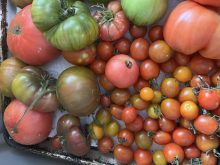We’ve been in deep summer heat for weeks now after a rainy spring, and every plant in my yard — including the quack grass and chickweed — is consumed with the green fuse of growth. The result is a cornucopia of everything. The scarlet runner beans and snow peas twining around their bamboo stakes tower far above my head in the raised beds. Carrot fronds and cilantro are trading jokes about feather boas, and the spinach has long since bolted for the coast. So, I called my son this morning to ask if he wanted baby beets, carrot thinnings, herbs, chard, arugula, red oak leaf and romaine, peas, beans, cherry tomatoes… Then I went out to water and weed and pick.
It’s that season. I pick the arugula and romaine; let it grow for a few more days while we finish what’s in the fridge; pick again. I max out the chard’s productivity by cutting, blanching and freezing it for winter lasagne and manicotti, and do it all again next week, eating fresh wilted chard dressed with green sauce in between. Well, of course I pick everything and keep on picking. With gratitude. The fields around us are in the same state of plenty, the best hay crop in 10 years. (Editor’s note: This column was written and submitted in July.)
Such plenty makes meals easy, and invariably vegetable-based. In the dog days, I lean on minimal kitchen heat, and we eat a lot of salad with protein. Last week I spatchcocked a bird and grilled it to eat cold with arugula, sugar snap peas, carrot thinnings and baby beets. Regularly, I make a big bowlful of bean salad to eat with red oak leaf and romaine tossed with watermelon cubes, corn kernels, feta, raspberries and snippets of chives.

But the truth of simple, sensational and succulent salads lies in the grace notes of garnish and dressing. These are things best done ahead so when mealtime strikes you simply open the fridge and pull out the ceramic bowls and glass jars along with those big tubs of washed greens.
Read Also

Syngenta rolls out Envita Dry nitrogen-fixing biological
A new formulation of the Envita bacterium distributed by Syngenta is expected to help farmers tap into more of the nitrogen crops need throughout the season — without adding more fertilizer.
READ MORE: Tips on growing leafy greens indoors
Quick-pickle a thinly sliced red onion for the snap and pucker of onion without its raw bite. Grill sliced eggplant and dress it in spicy oil and herbs — or yogurt and herbs — to enjoy cold on your greens. Grill extra corn for extra kernels to add to the bowl. Make quick pickles from thinly sliced cucumber in rice vinegar or julienned carrot in lime juice with ginger and hit chilies for a different take on texture and flavour.
When your herbs go crazy and you really can’t face making another batch of pesto to tuck into the freezer, make herb vinaigrette, or add them in handfuls to create a puckery green sauce that leans on pickles, capers and mustard to garnish a corn and mixed greens salad equally as well as grilled chicken, fish or ribeye.
It’s summertime, and the picking is easy. So first we eat, then we get back to the garden.

Summer green sauce/vinaigrette
This remarkably flexible dressing/sauce wears many hats in multiple cultures. As an Italian-derived salsa verde, or green sauce, it used to be hand-chopped for a rustic, chunky look. You can do that or whiz it all in the food processor for a smoother texture and shorter time in the kitchen. Use as a sauce atop grilled proteins or dilute to taste with a bit of water or vinegar and oil to serve as a salad dressing. It’s also great on soba or rice noodles with whatever protein takes your fancy. For an Argentine version called chimichurri, add hot chilies, paprika (sweet or smoked), and dried oregano or epazote. For a Peruvian style, make ají verde with lots of cilantro, mayo and lime juice, with a spicy yellow chili called ají Amarillo. Makes about 1 – 1 ½ cups
- 2 Tbsp. roasted unsalted pumpkin seeds or roasted nuts, minced (optional)
- 6-8 olives, pitted and chopped
- 2 Tbsp. capers, chopped
- 1 large dill pickle or several small gherkins, minced
- 2-3 anchovy filets, minced
- 1-2 Tbsp. local mustard
- a bunch each of mint, basil, and parsley or cilantro, leaves only
- 2-4 Tbsp. sherry vinegar or fruit-infused vinegar, to taste
- ¼ – ½ cup extra virgin olive oil
- salt and freshly cracked pepper to taste
Put the seeds or nuts, olives, capers, pickles and anchovies into a food processor with the mustard. Pulse until coarsely/smoothly chopped, as you like, scraping down the inside of the work bowl and adding a bit of water as needed.
Add the herbs and pulse again, then add the vinegar, oil, and seasoning. Process to blend, then taste. It should be acidic, but pleasantly so. Adjust the balance with additional oil, vinegar, salt and pepper to taste.















